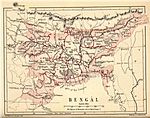This article needs additional citations for verification. (April 2020) |
Gour kingdom | |||||||||||
|---|---|---|---|---|---|---|---|---|---|---|---|
| 600-900–1303 | |||||||||||
| Capital | Borchola (first), Bank of Malini stream (royal) and Mona Rai hill (minister) | ||||||||||
| Languages | Sanskrit, Prakrit | ||||||||||
| Religion | Hinduism (official) | ||||||||||
| Government | Monarchy | ||||||||||
| Raja | |||||||||||
• 630-660 | Gurak (first (legendary)) | ||||||||||
• 1260-1303 | Gour Govinda (last) | ||||||||||
| Chief minister | |||||||||||
• 630-660 | Marbel (first) | ||||||||||
• 1060-1100 | Vanamali Kar | ||||||||||
• 1250-1260 | Madan Rai | ||||||||||
• 1260-1303 | Mona Rai (last) | ||||||||||
| Historical era | Classical period | ||||||||||
• Established | 600-900 | ||||||||||
• Disestablished | 1303 | ||||||||||
| |||||||||||
| Today part of | Bangladesh | ||||||||||
| History of Bengal |
|---|
 |
The Gour kingdom was one of the greater of the many petty kingdoms of the medieval Sylhet region. According to legend, it was founded by Gurak, off-shooting from Kamarupa's Jaintia kingdom in 630. Much of its early history is considered legendary or mythological up until Navagirvana who is mentioned in the Bhatera copper-plate inscriptions. The Kings of Gour are described as patrons of Hindu revivalism in what was previously a predominantly Buddhist and animist populated land.
The 11th century king Govinda-Rana Kesava Deva is recognised for introducing the navadinga (nine war boats) and heavily improving the kingdom's infantry, cavalry, and elephant power.[1] Due to familial tensions, the kingdom split into two separate kingdoms in 1170; Gour (Northern Sylhet) and Brahmachal (Southern Sylhet), before being reunited by Raja Govardhan in the early years of his reign. However, this would be short-lasted as during Govardhan's reign, the kingdom would suffer attacks from neighbouring kingdoms of all directions; eventually leading to the latter's death and the annexation of Brahmachal from Gour to Twipra. Gour Govinda would be the last king to succeed him. In contrast to Govardhan, he would revive Gour back into a regional superpower, warding off all potential enemies, regaining lost territory, introducing defensive strategies like archery in war for the first time in Bengal's history and improving Gour's military status.[2] Noted as a Hindu Revivalist, Gour Govinda encouraged the Hindu way of life . The kingdom came to an end after the Islamic conquest of Sylhet in 1303 led by Sikandar Khan Ghazi, Syed Nasiruddin and Shah Jalal, leading to the flight of Govinda and the royal family, and the subsequent incorporation of Sylhet with mainland Muslim Bengal ruled by Sultan Shamsuddin Firuz Shah.[3]
- ^ Cite error: The named reference
guptawas invoked but never defined (see the help page). - ^ Cite error: The named reference
potrowas invoked but never defined (see the help page). - ^ North East India History Association. Session (1980). Proceedings of the North East India History Association. The Association. p. 73. Retrieved 14 December 2018.
